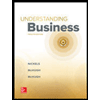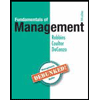
Concept explainers
To Determine:
The meaning of control and to provide the six reasons that makes it necessary.
Introduction:
Any organization has some goals that are preset. It is against these goals that its performance is to be compared.
Answer to Problem 1UTC
Solution:
The process of comparing the performance of employees of an organization against predetermined goals is called control. It helps identify irregularities, work with complexities, reduce costs, result in better teamwork, identify new growth areas and to easily adjust to changes.
Explanation of Solution
Control – Any organization has its own set of goals that are predetermined. The process of identifying these goals of the organization and observing the performance of their employees and contrasting them to the goals in order to facilitate corrective measures as needed is called control.
There are several reasons why control is needed. Some of them are explained below:
- To identify irregularities – Some irregularities or issues like reduced productivity, employee turnover etc, can be watched and corrected by control, thereby increasing the efficiency of the employees.
- Work with complexities − With organization growth, the levels within the organization will also increase. This implies that the product lines and production lines increase to different levels. With control, managing these levels and coordinating between these complex levels can be handled in a better manner.
- Reduces costs – With control, the management can now compare against the standards set for a particular activity, and so this could help them cut costs wherever feasible and improve the productivity.
- Better team work − At each level of the organization, control varies. With control, the management can now delegate the decision making capabilities to the lower levels to a certain extent. This thereby results in more co-ordination amongst the employees within and across different levels in the organization and leads to improving the team work.
- Identify new openings − With time, the choices and preferences of the customers also keep varying and so does the cost of the materials. So the organizations can predict such new openings and areas for their development. Control facilitates organization to modify their paths to conquer the new openings and opportunities available for them.
- Easily adjust to changes − Organizations need to handle a lot of changes in terms of technology, finance, government rules and regulation, etc. Control helps organizations to cope up with the changes happening.
Hence, the meaning of control and the six reasons that makes it necessary for an organization have been discussed.
Want to see more full solutions like this?
Chapter 16 Solutions
Management: A Practical Introduction
- tesla ebike new extended brand content: conclusion?arrow_forwardcontent:Overview of Apple Health as a Brand Extension?arrow_forwardI am designing a Management by Objectives (MBO) performance appraisal for the Training and Development Specialist position to be used I meet with the incumbent employee to explain your expectations for their performance over the next twelve months. I need 3 objectives that the employee will be evaluated on. Be sure to include the time line by which each goal will be met, as well as dates for review of accomplishments.arrow_forward
- Terminating an employee is often one of the most stressful, and in some cases, fearful decisions managers are required to take. After you read and understand the four bases (reasons) for terminating an employee on page 324 of your textbook you are to develop a short scenario as to why you have chosen an employee to be terminated. Following the scenario you are to prepare a step-by-step process for meeting with the employee being terminated. The process should be direct, without too much information that will cause a potential argument, but with enough information that provides background and future steps (last day of work, summary of benefits, if any, and expectations regarding employee behavior if the employee is returning to their work area until the actual termination date, rarely if ever the termination is due to insubordination). It should be assumed that you will have a fellow supervisor/manager or an HR professional in the termination discussion (terminations should never be…arrow_forwarduk unileaver stock exchange london , content: "abstruct"?arrow_forwardExplain how you can conduct rapid assessment in an area after the onset of an emergencyarrow_forward
- Brand name: UWTSD university in uk. *(I submitted before but I need more word, do not give screenshort just write and give, I will copy paste) Do not copy from another same ques answer, I need different one. Give image, table, graph with source, this full ques within 2500word TASK DESCRIPTION Successful brand extensions allow companies to diversify their offerings and increase their market share. Brand extension will provide any company a competitive advantage over its rivals that do not offer similar products. You are expected to select a live/real organisation which is suitable to the task and launch a new product/service. Please discuss with your lecturer your choice before proceeding. For your Portfolio you need to complete the following tasks: 1. Develop a new brand extension for the organisation you have selected for one of their product/service. 2. Determine segmentation, targeting and positioning for the new brand extension. 3. Develop a detailed customer personal profile for…arrow_forwardΓ Paragraph Г For uk stock exchange, London Unilever brand: Follow this data and give elaborate content (a) "Analysis", content: (b) "Unilever UK Financial Trends (2019-2023): A Critical Illustration" and content(c) "Summary of Unilever UK's Financial Performance (2019-2023)" uqaunoury Unilever UK Financial Trends (2019-2023) Table:4 Styles 2019 2020 2021 2022 2023 Debt to 1.96 1.64 1.64 1.42 1.50 equity ratio Debt to capital 43.60 39.56 39.51 36.54 37.99 rasio Table:5 2019 2020 2022 2023 2019 2020 2021 2022 2023 Table:1 Here is the graphical illustration of Unilever UK's financial trends from Asset 0.78 0.79 0.73 0.78 0.78 +2019 to 2023. turnover 2019 2020 2021 2022 2023 Fixed asset 4.6 4.5 5.0 5.7 5.6 turnover Sales 52.0 50.7 52.4 60.1 59.60 Table:6 2019 2020 2021 2022 2023 Profit 6.0 5.5 6.6 8.0 7.8 Inventory days 52.59 57.22 55.53 57.67 57.43 Inventory 6.9 6.7 6.6 6.8 6.2 Riviend 3.9 3.8 4.1 4.5 4.7 turnover Table:2 2019 2020 2021 2022 2023 Gross margin 44.01 43.45 42.30 40.23…arrow_forwardFor UK London stock exchange "Unilever" (a) Write a summary of this graph and Table 1. (b)Write content" Explanation" and Discussion" elaborately for all other tables 2-6 *individually. For UK London stock exchange "Unilever" (a) Write a summary of this graph and Table 1. (b)Write content" Explanation" and Discussion" elaborately for all other tables 2-6 *individually. 50 30 Unilever UK Financial Trends (2019-2023) Table:4 2019 2020 2021 2022 2023 Debt to 1.96 1.64 1.64 1.42 1.50 Sales (bn) Profits equity ratio Costs (bn) Dividends Paid (b) Debt to capital 43.60 39.56 39.51 36.54 37.99 rasio Table:5 2019 2020 2021 Year 2022 2023 2019 2020 2021 2022 2023 Table:1 Here is the graphical illustration of Unilever UK's financial trends from +2019 to 2023. Asset turnover 0.78 0.79 0.73 0.78 0.78 2019 2020 2021 2022 2023 Fixed asset turnover 4.6 4.5 5.0 5.7 5.6 Sales 52.0 50.7 52.4 60.1 59.60 Table:6 2019 2020 2021 2022 2023 Profit 6.0 5.5 6.6 8.0 7.8 Inventory days 52.59 57.22 55.53 57.67…arrow_forward
- For london stock exchange "Unilever brand: follow the image **(I submitted before: I need more word). Do not give me screenshort just wite and give. I will copy paste. Task two (Academic essay) Provide a 2,000-word essay that offers a critical evaluation of the main investment appraisal methods of those that may be applied in capital rationing decision-making by firms. You should provide an overview of each method, highlighting their respective strengths and limitations, and critically analyse their effectiveness in different investment scenarios. In addition, you should examine relevant theoretical concepts and use numerical examples from academic literature to support your arguments. Please ensure that your arguments are well-structured, logically organised, use supporting examples, calculations, and illustrations whilst adhering to proper referencing and citation guidelines while using relevant sources. As an academic essay, you should include an introduction, main body, and a…arrow_forwardfor brand name:UWTSD uk university brand: follow immage. **{Do not give me screenshot, submitted this ques before but the previous one gave screenshort type things. just write and give me, will copy paste.} Do not copy from another same ques answer, I need different one. Give image, table, graph with source, this full ques within 2500word TASK DESCRIPTION Successful brand extensions allow companies to diversify their offerings and increase their market share. Brand extension will provide any company a competitive advantage over its rivals that do not offer similar products. You are expected to select a live/real organisation which is suitable to the task and launch a new product/service. Please discuss with your lecturer your choice before proceeding. For your Portfolio you need to complete the following tasks: 1. Develop a new brand extension for the organisation you have selected for one of their product/service. 2. Determine segmentation, targeting and positioning for the new brand…arrow_forwardFor UK Unilever brand: 1.(a)A brief introduction and overview of the company's history and current in its respective marketplace. (b) A graphical illustration, together with a short written summary, of the five trends in sales, profits, costs and dividends paidarrow_forward
 Understanding BusinessManagementISBN:9781259929434Author:William NickelsPublisher:McGraw-Hill Education
Understanding BusinessManagementISBN:9781259929434Author:William NickelsPublisher:McGraw-Hill Education Management (14th Edition)ManagementISBN:9780134527604Author:Stephen P. Robbins, Mary A. CoulterPublisher:PEARSON
Management (14th Edition)ManagementISBN:9780134527604Author:Stephen P. Robbins, Mary A. CoulterPublisher:PEARSON Spreadsheet Modeling & Decision Analysis: A Pract...ManagementISBN:9781305947412Author:Cliff RagsdalePublisher:Cengage Learning
Spreadsheet Modeling & Decision Analysis: A Pract...ManagementISBN:9781305947412Author:Cliff RagsdalePublisher:Cengage Learning Management Information Systems: Managing The Digi...ManagementISBN:9780135191798Author:Kenneth C. Laudon, Jane P. LaudonPublisher:PEARSON
Management Information Systems: Managing The Digi...ManagementISBN:9780135191798Author:Kenneth C. Laudon, Jane P. LaudonPublisher:PEARSON Business Essentials (12th Edition) (What's New in...ManagementISBN:9780134728391Author:Ronald J. Ebert, Ricky W. GriffinPublisher:PEARSON
Business Essentials (12th Edition) (What's New in...ManagementISBN:9780134728391Author:Ronald J. Ebert, Ricky W. GriffinPublisher:PEARSON Fundamentals of Management (10th Edition)ManagementISBN:9780134237473Author:Stephen P. Robbins, Mary A. Coulter, David A. De CenzoPublisher:PEARSON
Fundamentals of Management (10th Edition)ManagementISBN:9780134237473Author:Stephen P. Robbins, Mary A. Coulter, David A. De CenzoPublisher:PEARSON





